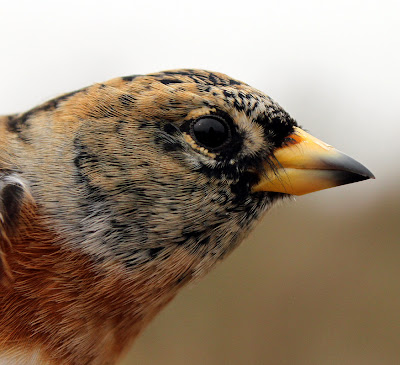The intention was to just fill the feeders and drop more seed for the hungry Bramblings at Rawcliffe, and then do a little birding, leaving the ringing for the better forecast of tomorrow. With the wind speed nil and a number of birds around I decided to stay for a while, until that is the wind picked up about 1030 and forced me to close the nets.
In the meantime more Bramblings appeared in the nets along with a national rarity, a Little Bunting Emberiza pusilla. Little Buntings breeds across the taiga of the far northeast of Europe and northern Asia. It is a migratory species wintering in the subtropics of northern India, southern China and the northern parts of Southeast Asia. It is a rare vagrant to Western Europe and the UK.
Birds caught: 4 Brambling, 3 Reed Bunting, 2 Chaffinch, 2 Goldfinch, 1 Little Bunting.
The Little Bunting was in a net alongside two Reed Buntings, the Little Bunting immediately recognisable because of its diminutive size, fine, straight bill, distinctive head pattern, obvious whitish eye ring and pink legs. The measurements were equally tiny, a wing length of 68mm and a weight of just 12.7 grams.
Little Bunting
Little Bunting
For comparison with the smaller bunting, one of today’s male Reed Buntings.
Reed Bunting - Emberiza schoeniclus
More Bramblings today takes the winter November to March total here to 55, so definitely something of a “Brambling Winter” with the second highest yearly total of this species for the ringing group. The Reed Bunting total for the same winter period stands now at 49 birds as the buntings continue to roam local farmland, eventually finding their way to my feeding station.
Brambling
Brambling
Mentioning Reed Buntings reminds me of a couple of recent records of their local autumn/ winter wanderings. The first involved a young bird Y763574 ringed in the summer of 2012 on July 30th at the Leighton Moss RSPB reserve, near Silverdale. I recaptured the bird at Rawcliffe Moss on 5th January 2013, a distance of just 34 kms - a fairly typical way that Reed Buntings seem to roam during autumn and winter.
A second record involves Y279071, a first calendar year Reed Bunting caught at Out Rawcliffe on 25th September 2011 and later caught by another ringer at Knott End on 29th January 2012. This bird too shows another typical short distance movement of just 10kms.
Reed Bunting movements
More bird news and pictures from Another Bird Blog soon. Stay tuned.






































 F
F















.jpg)














